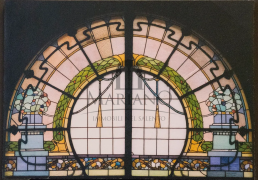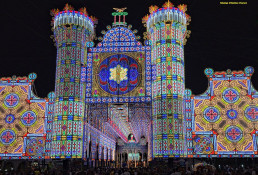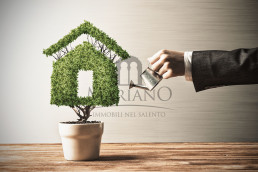Liberty Style in the architecture of Salento: a journey between elegance and innovation
Introduction
Salento, located in the south of Puglia, is a region of extraordinary beauty, renowned for its splendid beaches, rich cultural and culinary traditions, and its vast architectural heritage. Among the many influences that have shaped the local architecture, Liberty style, also known as Art Nouveau, occupies a prominent place. This style, developed between the end of the 19th and the beginning of the 20th century, has left a profound mark on the cities and villages of Salento, harmoniously blending decorative elegance and technical innovation.
Origins and Characteristics of Liberty Style
Liberty style was born in Europe between 1890 and 1910, as a reaction to the rigid canons of neoclassical architecture and growing industrialization. In Italy, the movement takes its name from the famous Liberty House in London, famous for its avant-garde furnishings and fabrics. Characterized by sinuous lines, floral motifs and an aesthetic that seeks to blend harmoniously with nature, Liberty stands out for the innovative use of materials such as wrought iron, colored glass and ceramics.
The Influence of Liberty in Salento
Salento, with its thousand-year history and strategic position in the Mediterranean, has always absorbed different cultural and artistic influences. Liberty architecture in Salento represents a meeting between local traditions and international trends of the time. This fusion is manifested in buildings that, while respecting traditional materials and construction techniques, introduce innovative decorative and structural elements.
Examples of Liberty Architecture in Salento
Lecce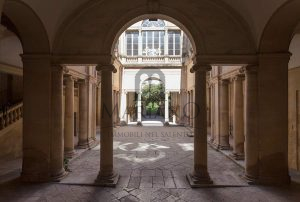
Lecce, often called "the Florence of the South", is famous for its Lecce Baroque, but also boasts notable examples of Liberty architecture. One of the most representative buildings is Palazzo Tamborino, built at the beginning of the 20th century. Its facades are decorated with floral and geometric motifs, and the interiors feature elegant stucco and artistic stained glass.
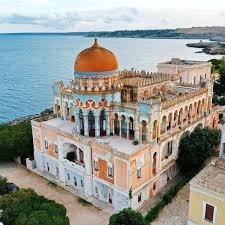 Santa Cesarea Terme
Santa Cesarea Terme
Santa Cesarea Terme, known for its thermal springs, is another jewel of Liberty architecture in Salento. Here Villa Sticchi stands out, a palace inspired by Moorish architecture, characterized by domes, arches and polychrome decorations. Built in 1894, Villa Sticchi represents a perfect example of how Liberty could integrate with different architectural styles, creating a highly suggestive effect.
Nardò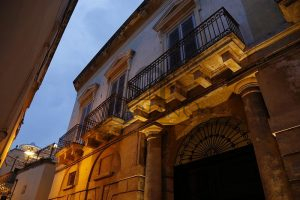
In Nardò, a town rich in history and art, Liberty style can be admired in buildings such as Palazzo Personè. This building stands out for its richly decorated façade, where the floral details and sinuous lines typical of Liberty combine with the elegance of the local Baroque.
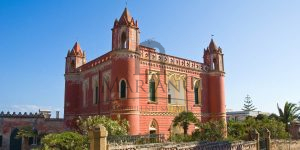 Santa Maria di Leuca
Santa Maria di Leuca
Santa Maria di Leuca experienced a period of great urban and architectural development between the end of the 19th and the beginning of the 20th century, when the nobility and upper middle class of Puglia began to build their summer residences along the coast. These villas, many of which in Liberty style, became symbols of elegance and refinement, transforming Leuca into an exclusive holiday resort. Among them we find Villa La Meridiana, Villa Mellacqua and Villa Episcopo.
Materials and Construction Techniques
In Salento, the Liberty style was able to adapt to the local environment, using materials such as Lecce stone, an easily workable calcarenite, which allowed for the creation of detailed and complex decorations. Wrought iron was widely used for gates, balconies and railings, often made by highly talented local craftsmen. Colored glass also played an important role, with windows and glass walls filtering light in an evocative way, creating plays of colors and reflections.
Living today in an Art Nouveau house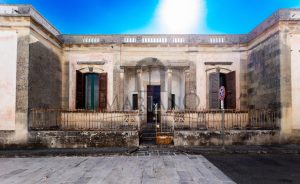
Our agency Mariano Immobili nel Salento is currently handling the sale of a prestigious property located in the heart of the historic center of San Cassiano, in the province of Lecce. It is an ancient stately home in Art Nouveau style, characterized by details of extraordinary beauty. The facade is embellished with a refined decorative parapet, while the entrance is adorned with a glass and wood door, full of elegant decorations in the same style. Inside, the polychrome cementine flooring adds a touch of color and refinement, making this home an authentic architectural jewel. With a careful and respectful renovation it will be possible to dive back into an elegant and refined style, without sacrificing the convenience of modern comforts.
Below is the link with a detailed description and photos of the property: https://www.apuliaproperties.com/immobile/historic-home-with-garden-for-sale-in-salento/
Conclusion
The Liberty architecture in Salento is a fascinating example of how an international artistic movement can integrate with local traditions, giving life to a unique and precious heritage. Through its elegant and innovative buildings, the Liberty style has enriched the urban and rural landscape of Salento, leaving a legacy that continues to enchant and inspire even today. Visiting these places means taking a journey through time, to discover an era of great cultural and creative ferment, which has been able to combine beauty and modernity in an absolutely unique way.
Real Estate Investments in Lower Salento: Analysis of the Local Real Estate Market for Investments in Historic Properties
Basso Salento, a sub-region located in the southern part of Puglia, is emerging as an area of great interest for real estate investments, especially for historic properties. This area, characterized by a rich cultural and natural heritage, offers unique opportunities for those who want to invest in properties with historical and architectural value. In this article, we will analyze the real estate market of Basso Salento, with a focus on the returns and potential future developments for investments in historic properties.
The context of the real estate market in Basso Salento

Attractions of Basso Salento
Basso Salento is known for its charming historic cities and villages, including Lecce, Otranto, Gallipoli and Santa Maria di Leuca. These urban centers are characterized by buildings in Lecce stone, baroque churches, castles and historic buildings. The historical charm, combined with a privileged geographical position between the Ionian Sea and the Adriatic Sea, makes Basso Salento a popular tourist destination, with a constant flow of Italian and international visitors.
The Real Estate Market
In recent years, the real estate market in Lower Salento has seen significant growth, driven mainly by the demand for second homes and properties intended for tourist rental. Investors are attracted by the prices that are still relatively affordable compared to other Italian regions, as well as by the potential for enhancing the value of historic properties.
 Historic Property Investments
Historic Property Investments
Historic Property Characteristics
Historic properties in the Lower Salento include masserie, palaces, courtyard houses and watchtowers, often surrounded by olive groves and vineyards. These properties not only represent an investment in terms of property value, but also offer the possibility of preserving and enhancing the local cultural heritage. The restoration and redevelopment of these properties require specialist skills and can benefit from tax incentives and public funding.
Investment Returns
Investments in historic properties in the Lower Salento can generate attractive returns, especially if the properties are used for tourism. The rental of holiday homes, bed & breakfasts and agritourism is a major source of income for investors. The growing popularity of Salento as a tourist destination has led to an increase in rental rates, with returns that can vary from 5% to 10% per annum, depending on the location and condition of the property.
Success Stories
Several restoration and redevelopment projects in the Lower Salento have demonstrated the potential for success of investing in historic properties. An example is the renovation of farmhouses transformed into luxury resorts, which have attracted an international clientele and significantly increased the value of the properties. Historic buildings in urban centers, repurposed as prestigious accommodation or residential facilities, have also recorded considerable appreciation.
attracted an international clientele and significantly increased the value of the properties. Historic buildings in urban centers, repurposed as prestigious accommodation or residential facilities, have also recorded considerable appreciation.
Potential future developments
Market trends
Future trends in the real estate market in Lower Salento indicate a further increase in demand for historic properties, supported by initiatives to enhance the territory and by policies to encourage tourism. The growing attention towards sustainable tourism and ecotourism could encourage investments in structures that integrate heritage conservation with eco-friendly practices.
Financing opportunities and incentives
Investors can benefit from various financing tools and incentives offered at national and regional level for the redevelopment of historic properties. These include non-repayable grants, tax breaks and low-interest loans, which can significantly reduce restoration costs and increase profit margins. (See: https://www.immobilinelsalento.com/agevolazioni-a-fondo-perduto-per-investimenti-immobiliari-in-salento-pia-e-minipia/)
Challenges and considerations
Despite the promising opportunities, investing in historic properties in Lower Salento presents some challenges. The restoration process can be complex, requiring careful planning and specialized skills. It is also important to consider the impact of local regulations on heritage protection and urban planning, which can influence the timing and costs of projects.
Conclusions
The Lower Salento represents a promising real estate market for investments in historic properties, offering attractive returns and long-term development potential. The charm of its cities and villages, combined with a growing tourist context, makes this area particularly attractive for investors who wish to combine economic profit with the valorization of cultural heritage. With an appropriate strategy and a good knowledge of the local market, investments in the Lower Salento can prove to be a profitable and sustainable opportunity
The magic of lights: the tradition of illuminations in Salento
Salento is famous for one of its brightest and most fascinating traditions: the luminarie. These spectacular light displays decorate cities and towns during religious holidays and special events, transforming the streets into real light shows. In this article, we will explore the origins, evolution, creation, installations abroad and the decorative use of luminarie in our homes.
Origins of Luminarie
Luminarie are an important cultural tradition admired throughout the world and represent a form of popular art that combines religious devotion and artistic creativity.
The term luminaria, from the Latin lumen, literally means "object that spreads light". Luminarie were made of papier-mâché and displayed during celebrations in the Renaissance, while in the Baroque period they were mounted on the facades of churches and cathedrals as a sign of devotion.
Originally, luminarie were nothing more than small oil lamps shielded by colored paper. The first prototypes can be found in the 16th century. Inspired by the designs for holiday decorations by artists such as Bernini, Fontana, Pietro da Cortona and even before Michelangelo, some artisans began to create structures illuminated with candles. The first evidence of illuminations in Puglia dates back to 1600, to accompany village festivals. Simple structures made up of poles and arches in fir wood, whose shapes recalled the Baroque style that was establishing itself in the region. Small glass containers with lamp oil and a wick for lighting were hung on the “parature”.
 Evolution of Illuminations
Evolution of Illuminations
Over the years, illuminations have undergone a remarkable evolution. From candles and torches, we have moved on to using electric bulbs, allowing for greater safety and a greater spectacularity. In the 60s and 70s, with the advent of technology, illuminations became increasingly elaborate, incorporating geometric, floral and baroque designs. In recent decades, technological innovations have led to the use of LED lights, which offer a wider range of colors and greater energy efficiency, allowing the creation of even more impressive installations.
How Are Luminarie Made
The creation of luminarie is an art that combines tradition and innovation. The process begins with the design of the drawings, which can include religious, floral, geometric or figurative motifs. These drawings are then transferred onto wooden or metal structures, which are then covered with LED lights or bulbs. The construction of the structures requires great craftsmanship and attention to detail to ensure stability and safety.
Luminarie are usually mounted on modular frames, which can be easily assembled and disassembled. This allows for flexibility in installation, adapting to different streets and squares. The end result is a series of arches, galleries and light panels that transform the environment into a breathtaking visual experience.
 Illuminations, Religion and Pagan Festivals
Illuminations, Religion and Pagan Festivals
Since ancient times, light has symbolized the divine presence in Christian countries, and candles were lit to illuminate places of worship during the most important liturgical celebrations. In the Renaissance, illuminations began to be displayed outside religious buildings, especially during the celebrations of nobles, who wanted to highlight their wealth. Every year, many cities and towns in Salento organize illumination shows, especially during religious festivals or cultural events. Illuminations are installed along the main streets, in squares and around churches, creating magical and evocative atmospheres. Salento is the region in the South where this tradition is most widespread. Of all the places, Scorrano is certainly the most famous, so much so that it is considered the world capital of illuminations.
According to a legend, during a plague epidemic, Santa Domenica asked the inhabitants who had been healed thanks to her intercession to display a candle outside the window. In a short time, all of Scorrano was illuminated by the warmth of the small lights. From July 5, on the occasion of the patron saint's day, the town is filled with illuminated structures up to 40 meters high. The event begins with a suggestive artistic show, in which the lights, which give life to real "ephemeral architectures" light up to the rhythm of music. This show of colored lights is so famous that it attracts visitors from all over the world.
Installations Abroad of the Lights
In recent years, the Salento lights have gained international fame, finding space in artistic installations and events all over the world. Cities such as New York, Tokyo, London and Paris have hosted the spectacular creations of Salento master luminaries. These installations not only promote the tradition and art of Salento, but also become a means of cultural exchange, fascinating audiences of different nationalities and cultures.
A significant example is the installation of the Salento lights during the Festival of Lights in Lyon, France, where the streets of the city were transformed into a magical landscape of light, attracting thousands of visitors and celebrating the art of Italian light.
 Decorative lights
Decorative lights
The charm and magic of the great luminous architectures of Salento can now be brought inside our homes, thanks to decorative lights.
These are light installations of various types, sizes and designs, designed to decorate and illuminate living spaces. They can be made with different materials, including wood, metal, glass and plastic, and are often characterised by intricate geometric, floral or abstract patterns.
The typologies present a very wide range of choice, which includes: table lamps, light garlands, pendant lamps, outdoor lanterns, wall decorations, etc.
Decorative lights serve various purposes, mainly related to the decoration and illumination of living spaces. Here are some of the main uses: creation of suggestive atmospheres, enhancement of spaces, decorations for special events, functional lighting, design elements, etc.
Conclusion
The tradition of luminarie in Salento is a celebration of light, art and community. From its humble beginnings with candles and torches, it has become a spectacular expression of creativity and innovation. Whether large public installations or home decorations, luminarie continue to enchant and bring joy, representing a luminous link between the past and the present, and between Salento and the world.
Ecotourism and Sustainability in Real Estate
Introduction
Ecotourism and sustainability are increasingly relevant concepts in the real estate sector. These principles aim to reduce the environmental impact of construction and tourism activities, promoting responsible use of natural resources and improving the quality of life.
Sustainable Real Estate Projects in Salento
Salento is an excellent example of how sustainable architecture can be integrated with eco-tourism. Some examples of sustainable real estate projects in the area include:
- Eco-Friendly Masseria Salentina:

An eco-friendly masseria salentina is a typical agricultural company that stands out for its sustainable and environmentally friendly approach. These masseria often combine traditional Apulian architecture with modern eco-friendly technologies, offering an authentic and sustainable experience to visitors. Here are some aspects that characterize an eco-friendly masseria salentina:
Traditional Architecture:
- Local materials: use of Lecce stone, tuff and other local materials for construction and renovation.
- Design: preservation of original structures such as internal courtyards, thick walls and vaulted ceilings.
Sustainability:
- Renewable energy: installation of solar panels for electricity production and water heating.
- Energy efficiency: use of thermal insulation systems to reduce energy consumption.
- Water management: rainwater collection systems and use of low-consumption irrigation technologies.
- Organic agricultural production:
- Vegetable gardens and orchards: cultivation of vegetables, fruit and aromatic herbs without the use of pesticides and chemical fertilizers.
- Local products: production of olive oil, wine, cheese and other typical products of Salento following sustainable practices.
- 0 km cuisine
- Seasonal menu: use of fresh and seasonal ingredients from the farm itself or from local producers.
- Traditional cuisine: preparation of typical Salento dishes with particular attention to quality and sustainability.
Guest Experiences:
- Ecotourism activities: guided walks, bike tours, cooking classes, craft workshops and tastings of local products.
- Wellness: offering services such as yoga, massages and holistic treatments in a natural setting.
- Eco-Resort in the Natural Park:
 Located in the heart of Puglia, the Salento Regional Natural Park is a protected area that extends along the Ionian and Adriatic coast, characterized by rich biodiversity, breathtaking landscapes and a unique cultural heritage. The creation of an eco-resort in this region offers the opportunity to promote sustainable tourism that enhances the natural and cultural resources of the area.
Located in the heart of Puglia, the Salento Regional Natural Park is a protected area that extends along the Ionian and Adriatic coast, characterized by rich biodiversity, breathtaking landscapes and a unique cultural heritage. The creation of an eco-resort in this region offers the opportunity to promote sustainable tourism that enhances the natural and cultural resources of the area.
Vision: to become a reference point for sustainable tourism in Salento, offering a unique experience that combines comfort, sustainability and immersion in nature.
Mission:
- Promote the conservation of the natural environment and local biodiversity.
- Offer high-quality accommodation and services in harmony with the environment.
- Educate guests on the importance of sustainability and conservation.
- Support the local economy through the use of local resources and labor.
Resort Features
Sustainable Architecture:
- Use of local and recycled materials.
- Bioclimatic design to reduce environmental impact.
- Renewable energy systems (solar panels, wind).
Accommodations:
- Ecological bungalows built with sustainable materials.
- Rooms with panoramic views of the natural park.
- Luxury suites immersed in nature.
Services:
- Restaurant that uses organic and 0 km products.
- Spa and wellness center with natural treatments.
- Guided excursions in the natural park.
- Environmental education activities and workshops on sustainability.
Activities and Experiences
- Excursions and Trekking: Guided routes to discover the flora and fauna of the park, with the possibility of bird watching and nature photography.
- Water Activities: Kayak and snorkeling trips to explore the pristine coasts and marine life.
- Culture and Tradition: Visits to local historical and cultural sites, tastings of typical products and participation in traditional events.
Sustainability and Conservation
Resource Management:
- Collectin and use of rainwater.
- Waste reduction and recycling programs.
- Use of renewable energy to reduce CO2 emissions.
Biodiversity Conservation:
- Collaboration with local authorities and environmental associations for the protection of habitats.
- Projects for the restoration of degraded areas.
- Monitoring and research on local fauna and flora.
Economic and Social Impact
Support for the Local Economy:
- Collaboration with local producers and artisans.
- Creation of jobs for the local community.
- Promotion of responsible tourism that respects the traditions and cultural identity of Salento.
Education and Awareness:
- Educational programs for schools and the community.
- Workshops and seminars on sustainability and conservation.
- Awareness campaigns aimed at the resort guests.
- Sustainable Agritourism:
Sustainable agritourism in Salento is an ideal option for those who want a holiday immersed in nature, respectful of the environment and local traditions. Salento offers many facilities that focus on environmental sustainability and authentic hospitality. Here are some common characteristics and tips for finding sustainable agritourism in Salento:
hospitality. Here are some common characteristics and tips for finding sustainable agritourism in Salento:
Characteristics of Sustainable Agritourism
- Use of Renewable Energy: Many agritourisms use solar panels, geothermal systems or other renewable energy sources to reduce environmental impact.
- Organic Farming: Sustainable agritourisms often grow organic products, ensuring healthy and zero-mile food for guests.
- Water Saving: Rainwater recovery systems and efficient irrigation practices are common to minimize water waste.
- Eco-Friendly Materials: The construction and renovation of buildings often uses natural and local materials, reducing environmental impact.
- Respect for Biodiversity: These agritourisms protect and promote local biodiversity, creating habitats for wildlife and using native plants in the gardens.
- Environmental Education: They offer educational activities and workshops to raise awareness among guests about the importance of sustainability and nature conservation.
How to Find Sustainable Agritourisms
- Online Platforms: Websites such as Ecobnb, Agriturismo.it and Booking.com allow you to filter the properties based on sustainability criteria.
- Certifications: Look for agritourisms with sustainability certifications, such as the Bio mark or the Ecolabel certification.
- Reviews and Feedback: Reading reviews from previous guests can provide useful information about the sustainable practices of the properties.
Tips for Making a Home More Eco-Friendly
For those who want to make their home more eco-friendly, here are some practical tips:
- Thermal Insulation:
- Improve the insulation of walls, roofs and floors to reduce heat loss.
- Use eco-friendly insulation materials such as rock wool or cork.
- Renewable Energy:
- Install solar panels to produce electricity or heat water.
- Consider using geothermal heat pumps.
- Water Management:
- Install rainwater collection systems for garden irrigation.
- Use low-flow faucets and showers to reduce water consumption.
- Sustainable Materials:
- Choose recycled or low-impact construction materials.
- Use non-toxic paints and finishes.
- Energy Efficiency:
- Replace old windows with high-efficiency double-glazed models.
- Install energy-efficient appliances.
- Design and Planning:
- Design your home to maximize natural light.
- Consider the orientation of your home to optimize natural heating and cooling.
The Importance of Sustainability in Modern Real Estate
Sustainability in real estate is essential for several reasons:
- Reducing Environmental Impact:
- Sustainable construction reduces CO2 emissions, consumption of natural resources and waste production.
- Saving Money:
- Eco-friendly homes tend to be more energy efficient, reducing utility bills.
- Sustainable homes often have a higher market value and quicker time to sell.
- Health and Well-being:
- Sustainable buildings improve indoor air quality and reduce exposure to harmful chemicals.
- Designing for natural lighting and the use of natural materials contributes to the well-being of the occupants.
- Social Responsibility:
- Adopting sustainable practices demonstrates a commitment to protecting the environment and future generations.
- Real estate companies that invest in sustainability often enjoy a better reputation and attract more conscious customers.
Tips for a Sustainable Holiday
- Respect for the Environment: Reduce plastic consumption, recycle and save resources such as water and energy.
- Support the Local Economy: Buy local products and participate in activities offered by local communities.
- Sustainable Mobility: Use eco-friendly means of transport, such as bicycles or public transport, to explore the area.
Conclusion
Integrating sustainability into the real estate sector is not only an ethical choice but also a necessity to ensure a prosperous and environmentally friendly future. Projects such as those in Salento show how it is possible to combine tradition and innovation to create living and tourist spaces that respect nature and improve the quality of life.
The Lecce stone
“In Lecce even the poorest houses are tasteful. In no other city have I seen so many doors, windows, loggias, pillars, balustrades all made of stone. Stone is easy to work here. "
(George Berkeley)
George Berkeley, famous theologian and philosopher considered, together with John Locke and David Hume, the father of empiricism, wrote some splendid words about Puglia and in particular about Lecce which he, in his "Travel diary in Italy" (1717), he defined in no uncertain terms "the most beautiful city in Italy". The philosopher appreciated the architecture of churches, convents and noble palaces, as well as the surrounding landscape and also expressed convinced praises on the people who lived in the city, of which he wrote "civilized and educated people, it seems that they have inherited the amiability of the ancient Greeks who in the past inhabited these parts of Italy ", but as the quote at the opening of this article shows, only part of the beauty of local architecture escaped his gaze as a sensitive empiricist, beyond the mastery of the craftsmen who built them, it was also due to the quality of the stone used in the construction, the famous “Lecce stone”.
The Lecce stone, called in dialect "leccisu", is of calcareous origin, is part of the group of marly calcarenites and its formation was identified by technicians in the Miocene period, or about 20 million years ago. Among its properties is the presence, in the formation itself, of shell fragments, small fossils that geologically enrich the structure, but also of clays, quartz and minerals that fortify it and make it even more unique. It is straw yellow in color, but the particularities of its composition enrich it with infinite shades that make it even more intriguing and spectacular.
In addition to characterizing it on a visual level, the very nature of the stone makes it very sensitive to the action of natural atmospheric agents, such as humidity or water stagnation, and also to agents of human origin such as smog. To make it more resistant, the master sculptors of the Baroque era used to treat the rock with milk, in fact lactose, penetrating inside the stone thanks to its porosity, endowed it with a waterproof protective layer, without altering its aesthetic qualities. This treatment also made it easier to process. Today the lactose-based treatment has not completely disappeared, but is joined by other more technological and modern treatments. It must be said that the wear of time sometimes enriches the Lecce stone, adding to its natural beauty a further very fascinating and warm chromatic range, with colors ranging from beige to amber and even, in some cases, to deep pink shades. The ease of processing Lecce stone, known for some time as the quote with which this article opens, is a feature that has certainly contributed to the local and later worldwide success of this precious material.
Lecce stone is mostly extracted in open-air quarries found above all in the municipalities of Lecce, Corigliano, Melpignano, Cursi and Maglie, at a depth of up to 50 meters; the hardness of the stone varies according to the depth of the extraction point and while the one extracted at more superficial levels is used above all to create sculptures and decorations, from the deep, harder benches, the material to be used in construction is extracted, to make plans and is also used as a refractory stone for fireplaces.
Lecce stone is part of the soul of Lecce Baroque, the architectural style born in the Salento capital between the end of the sixteenth century and the first half of the eighteenth century, recognizable for its splendid decorations that characterize the coatings of the buildings. The style, influenced by the Spanish Plateresque, owes its birth to the work of local architects such as Giuseppe Zimbalo (1617-1710) and Giuseppe Cino (1644-1722). The fruits of this peculiar style to be absolutely known are the Palazzo dei Celestini, the church of Santa Croce, the Church of Santa Chiara, the Church of Santa Irene and the Duomo, we will talk more about it on this blog. The Lecce stone enjoyed great success during the Baroque era, but it was already appreciated in the classical and pre-classical era.
Among the sculptors who have used and still use the Lecce stone today, we point out the work of Stefano Garrisi, Renzo Buttazzo, Antonio Margarito and Andrea Serra.
The Porto Selvaggio Regional Natural Park
Ten kilometers away from the Municipality of Nardò and a little less than twenty from the Municipality of Gallipoli there is an obligatory stop for those visiting Salento: a natural oasis that includes the Cala di Porto Selvaggio, the Palude del Capitano and the Torre dall 'Alto, a natural area protected by regional law since 2006 and included in 2007 in the list of "100 places to save" of the Italian Environment Fund (FAI).
We said an obligatory appointment, for lovers of seaside resorts, sports and nature in general. You can get there by driving a few minutes from the Municipality of Nardò and after having parked in one of the stops used, you walk a few hundred meters and find yourself in front of a natural spectacle to rub your eyes, a long descent immersed in nature leads in fact to a small beach of gravel and pebbles with a crystalline sea, whose waters are particularly refreshing and invigorating, also due to a current of fresh and cold water that reaches directly into the bay. The beach is surrounded by a large pine forest, whose trees were planted in the 1950s to reclaim the largely marshy surrounding land.
Within this natural park, which is not limited to the beach area, but includes over four hundred hectares of land, of which over two hundred and sixty of pine forest, there are various itineraries and different possibilities to relax or play sports; there are in fact the surrounding cliffs, a little more inaccessible than the "pine forest area", but which still allow bathing, there are also the numerous paths inside the pine forest, usable for walks or picnics and which are also an unmissable appointment for lovers of trekking and mountain biking. Speaking of trekking, among the most remarkable views of the park, returning to Gallipoli, you can go up along the pine forest and admire the Tower of Santa Maria from the High, an ancient watchtower, located 50 meters above sea level, on a rocky spur overlooking the beach, from which you can enjoy a breathtaking view of the entire natural park. The tower was erected in the second half of the 16th century and was part of an elaborate system of defensive turrets spread over the entire Salento coast, communicating to the north with Torre Uluzzo and to the south with Torre Santa Caterina. This system of turrets represents a historical heritage of the Salento area, but in a certain sense it is also an emotional heritage for the local population, as each of these turrets marks the landscape of the Salento coast in a unique way, we will talk about it in more detail with another article on this blog.
Speaking of history, the Porto Selvaggio Natural Park, in addition to the landscape treasure and the possibilities for sports of various kinds, also offers unmissable opportunities for archeology enthusiasts: eight different archaeological sites in the cave have been identified within the park , a sign of presence first by Neanderthal groups and subsequently by Sapiens, and the territory of the Municipality of Nardò is the center of an extraordinary "district of prehistory", with a historical stratification ranging from Neanderthal and Sapiens frequentations to those left by Messapi and then later by the Romans, up to the baroque architecture of the historic center of the same municipality. The Museum of Prehistory of Nardò, located in the former convent of Sant’Antonio da Padova, preserves most of the finds from archaeological research conducted in the area.
This wonderful natural oasis is located on the side of the Salento coast that faces west and therefore those who are there at sunset will see the sun slowly sink into the sea, we therefore recommend that you end your day in Porto Selvaggio with an aperitif in one of the numerous bars or kiosks between the natural oasis and Gallipoli, you will end a simply perfect day at the beach.
The sentinels of Salento: the history of the coastal towers
The coast of Salento always offers a remarkable panoramic spectacle, whether you go up it towards the north of the region from the eastern part or towards the city of Taranto from the western Ionian part, or that you descend it towards the Capo di Leuca, the beauty of the glimpses is always worthwhile and it is difficult to resist the desire to stop and enjoy the view of the sea, the golden sunrises or the fiery sunsets.
Those familiar with these splendid landscapes will have noticed that there are often stone turrets, or the remains of these, to shore up these views, as if they had been placed there for aesthetic reasons, as if to act as a vertical counterpoint on the mainland to the horizon. fixed of the sea. They almost represent milestones in the economy of the landscape, they also constitute an emotional heritage for the local population that associates with the surrounding marinas, so much so that some of these towers over time have become part of the Salento toponymy, even if officially as a "locality", often these towers indicate places of their own, for an inhabitant of the area going to Porto Miggiano is different than going to Santa Cesarea Terme, despite Porto Miggiano being a "locality" of the Municipality of Santa Cesarea Terme.
But what do we know about these towers? When were they built and for what reason? It is interesting to answer these questions because the answers tell us a lot about the history of Salento and more generally of all of Southern Italy. The construction of coastal towers has an essentially military reason, they have always been primarily outposts for sighting and defense from the incursions of enemy armies or "pirates", those of which traces remain on the territory or in historical documents all date back to medieval times, although it is probable that some of them were also built in previous eras, but no trace remains of these, those that remain visible today date back either to the years of the 11th century or, in most cases, to the years between XVI and XVII centuries, the years in which Don Pedro Álvarez de Toledo y Zúñiga reigned over all of Southern Italy as Viceroy of the Kingdom of Naples, on behalf of Charles V of Habsburg.
The first coastal towers in Southern Italy were therefore built in the 11th century to defend the territories from pirate raids, but due to the continuous political changes that never allowed a stable administration of the territory, a real integrated and functioning defense system on the whole coast was never finished and the few towers built ended up becoming the property of local families, who used them to defend and guard their possessions exclusively. Things changed in the mid-fifteenth century, when the raids on the Italian territory of pirates and especially of the Ottoman invaders became more and more frequent, in fact the capture of Otranto by the Ottoman invaders dates back to the year 1480, who in reaching the Salento town did not they found practically no resistance, above all they were able to land on the Salento territory without being sighted and therefore without anyone notifying the citizens of Otranto.
Just following the tragic event, Don Pedro de Toledo, who became Viceroy of the Kingdom of Naples in 1532, decided to implement and operate the system of control turrets, which had to be enough to be able to monitor the entire coast of Southern Italy and since the the main danger was the increasingly powerful Ottoman Empire and therefore it came from the East, it was Salento, due to its exposed geographical position, that was at the center of this surveillance system. This type of enterprise, that is the construction of over 300 coastal towers, for the canons of the time was not at all trivial, also for a matter of costs, so the towers were often built with a rather innovative "procurement" system for the time , or rather the construction was entrusted to a private individual who in exchange for the work could boast the military title of "Captain of the tower". There was no shortage of unforeseen events, for example in some cases these private individuals, despite the precise indication of the Viceroy to use fresh water for the processing and laying of materials, used the salt water of the sea to save costs, but the towers built with the salt water suffered from erosion and collapsed in no time. Despite these unforeseen events, the work was slowly completed and the Kingdom of Naples suffered the Ottoman advance with less and less damage, until the decisive battle of Lepanto in 1571 averted the Ottoman danger for our coasts forever.
The heritage of architectural eclecticism in Salento: the Moorish palaces
In architecture, “eclecticism” is defined as a current that aims at mixing the best stylistic elements present in the various architectural movements. The movement was born in England in 1700, then in the following century it spread widely to the rest of Europe, eventually reaching southern Italy as well. In its initial phase, European architectural eclecticism drew its ideas from different historical periods, with the birth of neo-Greek architecture, followed by the neo-Renaissance and then by the neo-baroque, but over the years the interpreters of eclecticism sought the their inspiration not elsewhere in time but in space, in the architecture of distant and exotic places, hence the Neo-Moorish and Neo-Egyptian architecture, but there was also no lack of Chinese and Indian influences.
What we will look at more closely is the neo-Moorish style, which left splendid traces in the Salento peninsula, but which arrived in the West primarily in France, following Napoleon's expedition to Egypt in 1798, and later developed in England and in other European countries, also due to colonialism in the East. Among the most distinctive elements of Moorish architecture we note the presence of circular domes, generally surmounted by a pointed spire, the use of bright colors and a large amount of intricate decorative motifs.
One of the most shining examples of this style in Salento is undoubtedly Villa Sticchi in Santa Cesarea Terme, a splendid building set in one of the most beautiful corners of the entire southern coast of the Adriatic, majestic and immediately recognizable even from far away, for reasons functional as well as aesthetic: the imposing central pagoda, in fact, which makes its profile so unmistakable, at the time was also designed to reflect the sunlight and become a beacon for ships sailing off the coast. This private residence can be considered a real icon of the local area, it was completed in 1894 on the ambitious project of the engineer Giuseppe Ruggeri, who signed many other Moorish residences on the two coasts of Salento, including the one he occupied as his own residence. in Leuca, or Villa La Meridiana, with an octagonal plan and also unmistakable from the outside due to its lively red and yellow parallel bands.
Another very interesting case is that of the “Eclectic Villas of the Cenate”, which take their name from the place where they were built, the Cenate in fact. These stately villas were designed and built between the end of the nineteenth century and the beginning of the next, in the midst of the "eclectic period" and we can admire them on the roads that lead from Nardò to the marinas of Santa Maria al Bagno and Santa Caterina. Walking or cycling through these country roads suddenly, in the middle of the characteristic olive trees, these precious baroque villas appear, in Art Nouveau style or even here in neo-Moorish style, as in the case of the beautiful Villa Saetta (now De Michele) and Villa Cristina dei Personè (now De Benedittis).
This desire to experiment and enrich the local landscape with exotic motifs and shapes was not limited to the coast but also took hold in the city of Lecce, only that while for the summer residences you could indulge yourself in the decorations, especially with the colors, city eclecticism took on less pronounced tones. In Lecce, however, there are some examples of nineteenth-century villas resulting from the architectural eclecticism of the period, almost all along the avenues created at the end of the nineteenth century in place of the newly demolished sixteenth-century walls. Interesting for the variety of architectural characters is Villa Bray, in neo-Moorish style, with an inscription in Arabic characters under the cornice, decorated with horizontal yellow and red bands: on the first floor the windows have horseshoe arches, on the second the arches are Byzantines, on the pointed arch gate. Villa Indraccolo also has oriental-style decorations. Another example of eclecticism declined according to local taste is Villa Himera, whose friezes are carved in Lecce stone.
The farms in Salento
Throughout Mediterranean Europe, as well as in many areas of North and South America and also elsewhere in the world, there are large rural buildings, known by various names: hacienda, ranch, farm, baglio, the Catalan masia or precisely the masseria, typical of Southern Italy, which we will deal with in this article.
These buildings had common characteristics: large spaces, the presence of internal courtyards, very often used as an orchard and also used as a farmyard for poultry, stables and large spaces used for the conservation or production of food. Obviously, wells and cisterns could not be missing and often there were increasingly advanced tools and technologies, such as the oil mills that were supplied to many of these buildings in Southern Italy. Wells and oil mills were also often made available to inhabitants outside the farm, which therefore became the most important meeting and social center of all the neighboring areas.
From the fourteenth century onwards, after the first imports of tobacco into Europe and with the increasing diffusion of the various uses of this plant, tobacco factories, generally smaller in size and more elementary in their size, obviously spread across the continent alongside the farms. structure, but they too survived the industrialization of tobacco production and were reborn as valuable housing units. In Castrignano del Capo, for example, you can admire the Antico Tabacchificio local, dating back to the nineteenth century, with an enviable position, halfway between the town and the splendid seaside resort of "le Felloniche", and with an elegant architecture in full harmony with the surrounding countryside, a clear example of an ancient agricultural production center destined to become a residential unit of absolute value.
The fact that more or less buildings of this type can be found all over the world is due to their common origin, that is, the large landholdings, known to us as "estates", which for many centuries have been the only production model. farming around the world. The large owner, who often lived in the few inhabited centers that existed at the time, far from the cultivations, granted the peasants (in our case called "massari") the possibility of living in these buildings, which served as the final center of production and conservation of agricultural products. Sometimes, however, the owner lived on the farm together with the peasants and in this case the architecture of the building reflected the difference in status of its inhabitants, with the owner family who lived on the upper floors or in the central buildings and the peasants relegated to the lower floors. or in peripheral structures.
Where the historical events and the conflicts that followed required it, the farms were fortified and also became bulwarks against foreign invasion; in Salento for example, after the Turkish invasion of 1480, King Charles V decided to strengthen the defense of the territory, arranging the construction or renovation of existing buildings, equipping them with towers for sighting of enemies and fortified fences. In the Salento peninsula, therefore, there are several, the Masseria Torre Casciani, the Masseria Melcarne and the Masseria Torcito, surrounded by a very rich vegetation and much loved by the local citizens for the possibility of hiking and picnics, just to name a few.
A separate note deserve the farms in some way connected to the Roman Church or to ancient noble families related to it, which were entrusted and managed by monastic or knightly orders, in these obviously there was always a small chapel to await the daily religious functions. that marked the day. In the Municipality of Surbo the splendid Masseria Schiavelle survives the decay, of which one can still admire the severe architecture halfway between the residential and the military complex.
The production model based on large estates was the only one known all over the world until almost the twentieth century, when a progressive democratization of agricultural production and therefore also of the society that revolved around it, together with the evolution of production, conservation and of the commercialization of agricultural products, it has broken up and divided the estates making the farms and other architectures similar to them obsolete and useless for large-scale agricultural production; from this moment the destiny of these structures has changed, in some cases they have been condemned to a slow ruin, to abandonment or conversion into anonymous warehouses, but fortunately they have become more and more luxurious homes. , and gradually more and more appreciated and requested. The transformation was often easy, as the farms were built already from their origin taking into account a certain aesthetic and architectural taste, thanks to the skill of craftsmen and masons who worked stone, carparo or tuff. Very often these were buildings built with a view to functionality, to make life in the fields less difficult and therefore to ease the fatigue of the settlers, offer practical solutions and ensure maximum usability of the environments, respecting a certain balance between man and nature, between the building and the territory, but the aesthetic taste of the masters of the time always added something to these needs for balance and functionality, such as the façades whose solemnity can remind us of a church rather than an ordinary home. Many examples of this precious architecture can be seen around the Salento countryside, for example the Masseria Santa Barbara, which we recommend you admire on your next visit to the town of Otranto.
The Lecce Baroque: men and monuments
In a previous article on this blog we have already analyzed the historical origins of the Lecce Baroque, listing some events and circumstances that favored its birth and development, from the Spanish presence in the Kingdom of Naples to the end of the threat brought by the Ottoman Empire up to the Council of Trento and the vast availability of precious stone from Lecce; each of these circumstances had a significant weight in the development of the architecture that redefined the panorama of the city of Lecce from the mid-sixteenth to the eighteenth century, but alongside the favorable circumstances and historical events, the Lecce baroque owes its fortune also to the vision , to the perseverance and commitment of some historical figures of the Salento capital, such as the bishop Luigi Pappacoda or the architects Giuseppe Zimbalo and Giuseppe Cino.
Luigi Pappacoda in June 1639 was called to govern the diocese of Lecce and remained bishop until his death in 1670. He held two diocesan synods in the city in 1647 and 1663 and in 1658 approved the election of the saints Oronzo, Fortunato and Giusto to the patrons of Lecce, restoring the ancient cult. In 1659 he laid the first stone for the construction of the new cathedral and commissioned numerous other works from the architect and sculptor Giuseppe Zimbalo. On his death he was buried in the Cathedral of Lecce, in the sepulcher near the altar of S. Oronzo.
As we have seen, the figure of the bishop Luigi Pappacoda is linked to that of the sculptor and architect Giuseppe Zimbalo, known as "the Zingarello" (the nickname is none other than the Italianization of the dialectal term "Zimbarieddhu" or the little Zimbalo, probably to distinguish it from father Sigismondo, also an artist of the stone) was the most famous and imitated architect of the Lecce Baroque. In the Salento capital the artist created the lower façade of the Celestini Convent, the Cathedral, the column of Sant 'Oronzo and the Church of the Rosario.
As for the architect and sculptor Giuseppe Cino, he worked in the Salento capital from the mid-seventeenth century, continuing the stylistic research of Giuseppe Zimbalo, whose construction of the Palazzo dei Celestini, for example, was completed. Cino was also responsible for the construction of the splendid Church of Santa Chiara, the Church of the Alcantarine and the Church of the Carmine, on which he worked until his death. He also designed the Seminary on commission of Antonio Pignatelli, at the time the new bishop of Lecce.
The Basilica of Santa Croce, together with the adjacent former Celestini Convent, constitutes the highest manifestation of the Lecce Baroque. A monastery had already been built in the 14th century in the area of the current basilica, but it was only after the middle of the 16th century that it was decided to transform the area into an entirely monumental area and to have the necessary space all of them were requisitioned. the properties of the local Jews, expelled from the city in the year 1510. The works for the construction of the basilica lasted for over two centuries and involved the most important Lecce architects of the time. The first phase of construction lasted from 1549 to 1582 and saw the construction of the lower area of the facade, while the dome was completed in 1590. The next phase of the works, starting from 1606, during which the three decorated portals were added to the facade , is marked by the commitment of Francesco Antonio Zimbalo, then Cesare Penna and Giuseppe Zimbalo worked on the final completion of the work.
The history of the Cathedral is very similar: a first cathedral of the Diocese of Lecce was built in 1144 by the bishop Formoso; in 1230, at the behest of the bishop Roberto Voltorico, the cathedral was renovated and rebuilt in Romanesque style. Subsequently, in 1659, the bishop Luigi Pappacoda gave Giuseppe Zimbalo the task of rebuilding the church in the Baroque style. The construction ended in 1670. The bell tower of the Duomo was built between 1661 and 1682, again by Giuseppe Zimbalo; was built to replace the Norman one, wanted by Goffredo d '
Altavilla, which collapsed at the beginning of the seventeenth century, and has a height of 70 meters; from its summit it is possible to admire the Adriatic sea and on particularly clear days also the mountains of Albania.
Also in the Piazza del Duomo is the Palazzo del Seminario built by the architect Giuseppe Cino between 1694 and 1709, commissioned by Bishop Michele Pignatelli. In the atrium you can admire a decorated well, also the work of Cino, while inside the building there is a chapel from 1696. On the first floor of the building we also find the "Diocesan Museum" and the "Innocenziana Library", so called by the name assumed by Pope Innocent XII, who had been bishop of the city. The library contains over ten thousand volumes, including from the fifteenth and sixteenth centuries.
The Church of Santa Chiara is located in the historic center of Lecce, in Piazza Vittorio Emanuele II. Its first foundation, wanted by the bishop Tommaso Ammirato, dates back to 1429; it was subsequently almost completely renovated between 1687 and 1691. The construction of the church, which remained without the upper pediment, is also the work of the architect Giuseppe Cino.
The Church of Sant 'Irene dei Teatini is located in the historic center of Lecce and is dedicated to Sant' Irene da Lecce, protector of the city until 1656. It was built starting from 1591 on a project by the Theatine Francesco Grimaldi and was completed in 1639, year of consecration by the bishop of Brindisi. The Church of Sant 'Irene was also at the center of important non-religious historical events: in 1797 it was visited by King Ferdinand IV of Naples, while in October 1860 it hosted the plebiscite operations to decide Lecce's yes to enter the Kingdom of Italy. In 1866 the annexed Convent of the Theatines was suppressed, but the church was still open to worship.
There are obviously many examples of the Lecce Baroque style also in other municipalities of the Salento peninsula, such as the Cathedral of Gallipoli or the Mother Church of Casarano.




